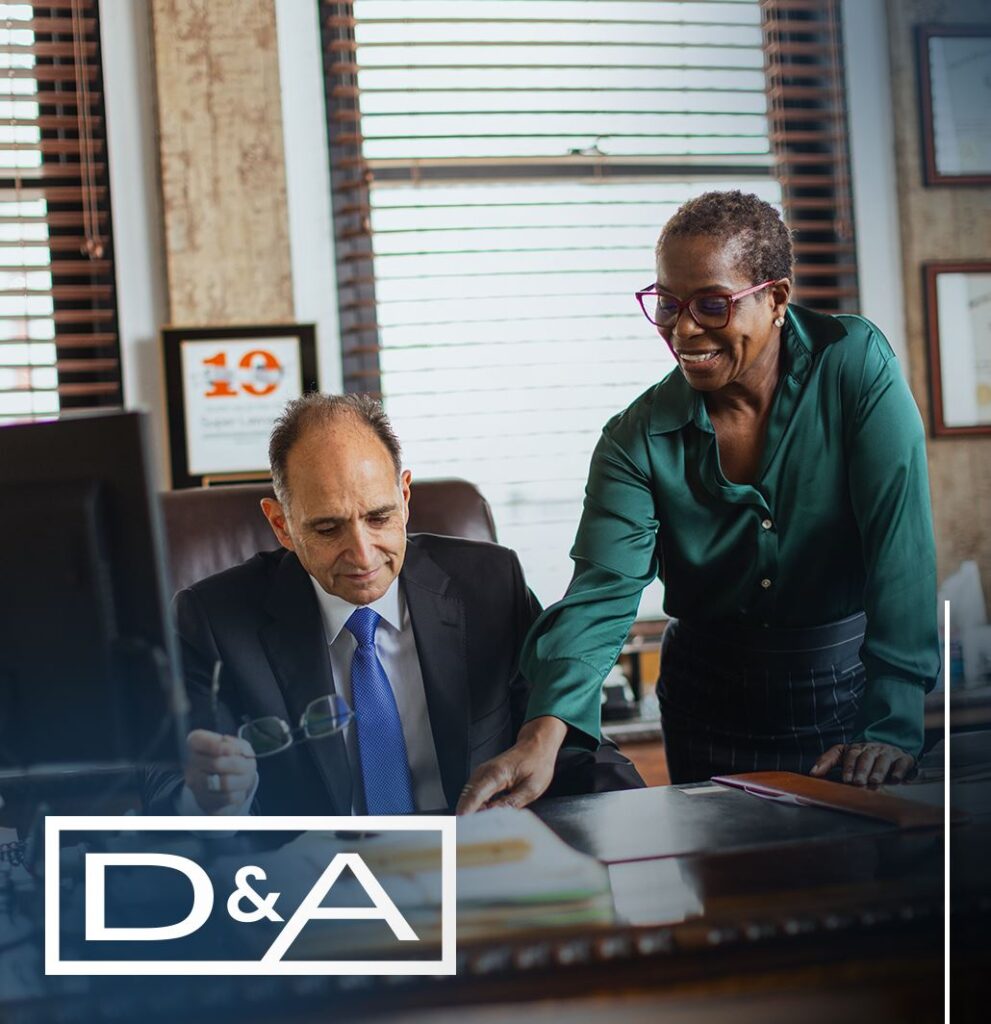New York City Scaffolding Accident Attorneys
See More Case Results
New York City Scaffolding Accident Attorneys
The construction industry is one of the most dangerous fields for worker safety. Research shows that the rate of fatal accidents is highest among construction workers, and the construction industry accounts for twelve of America’s deadliest jobs. Poor scaffolding and the failure to provide adequate safety devices are leading causes of falls among construction workers.
If you’ve been involved in a scaffolding accident and are seeking legal representation, Dansker & Aspromonte LLP Associates is the law firm you can trust. With a track record of success and a dedication to justice, here’s why you should consider hiring Dansker & Aspromonte LLP for your case:
- Proven Track Record of Success: Since its establishment in 1989 by Paul D. Dansker and Salvatore Aspromonte, our firm has secured over $500 million in verdicts and settlements for our clients. This impressive record showcases our ability to achieve favorable outcomes and obtain just compensation for victims of negligence.
- Recognized Excellence: The attorneys at Dansker & Aspromonte LLP have received numerous accolades and awards for their outstanding legal representation. These honors include being named Top Attorneys in the Metro New York area and being recognized as America’s Most Honored Professionals in the Top 1%. Additionally, our attorneys have attained the highest possible Martindale-Hubbell Distinction by both Peers and the Judiciary, highlighting their exceptional legal skills and ethical standards.
- Personalized Attention: We believe in the importance of listening to our clients’ questions, concerns, and needs following an accident. Our team is committed to providing you with the individualized support and guidance necessary to navigate the complexities of your scaffolding accident case. You can trust us to be attentive, responsive, and compassionate throughout the entire legal process.
- Experience and Trustworthiness: Dansker & Aspromonte LLP is highly respected among both clients and peers. Our attorneys are consistently recognized as top professionals in the field of personal injury law. With the National Association of Distinguished Counsel honoring us as the Nation’s Top One Percent and our AV Preeminent rating for 15 years, you can have confidence in our experience, knowledge, and ability to effectively represent your interests.
- Dedicated Advocacy: When you hire Dansker & Aspromonte LLP, you gain a team of dedicated advocates who will fight tirelessly to secure the compensation you deserve. We understand the physical, emotional, and financial toll a scaffolding accident can have on your life, and we are committed to pursuing justice on your behalf.
For a free legal consultation, Call or text (212) 732-2929 or complete a Free Case Evaluation form
How do New York City Scaffolding Accidents Happen?
Scaffolding is any temporary structure that construction workers use to reach elevated areas. While scaffolds are a common sight in New York City, they are also responsible for numerous construction accidents.
Unstable scaffolds lead to falls, one of the top causes of construction worker deaths. Scaffolding accidents can happen due to:
- Missing guardrails or toe boards on the scaffold
- Failure to provide harnesses, anchorages, or lifelines
- Unstable harnesses, anchorages, lifelines, tie-ins, or tie-backs
- Poorly structured materials or dimensions
- Overloading and burdening the scaffold
- Scaffolding collapses
- Falling objects
After an accident, your employer is responsible for providing you with workers’ compensation benefits. However, a qualified scaffolding accident lawyer can help you take legal action against the property owner, contractors and construction management firms that are liable and responsible for compensating you for your injuries and damages.
Injuries You May Sustain After a Scaffolding Accident
According to scaffolding statistics from the Occupational Safety and Health Administration (OSHA), 2.3 million construction workers (65% of the entire industry) use scaffolds. But on average, scaffolding-related accidents lead to 4,5000 injuries and 60 fatalities each year.
Since most scaffolding accidents involve falls from elevated work sites, these types of construction accidents often lead to critical and life-threatening injuries. In our experience representing scaffolding accident victims, the most common injuries include:
- Traumatic brain injuries
- Spinal cord injuries
- Fractured bones
- Paralysis
- Amputation
- Tears of ligaments and cartilage
If you suffered injuries due to a fall from scaffolding or other elevated work site, you deserve financial recovery. The experienced injury lawyers at Dansker & Aspromonte LLP Associates will review your case and help you pursue damages against all responsible parties.
Our legal team is well-versed in New York construction laws, and we will fight for the financial compensation you deserve.
Contractors and Property Owners Must Keep Scaffolding Safe
If you must use scaffolds to perform your job duties, then the building owner, general contractor, and construction site manager have a duty to keep scaffolding platforms safe. New York laws enforce that construction scaffolds maintain proper erection and workers receive necessary safety equipment to perform their jobs safely and without injuries.
Property owners and contractors who do not adhere to scaffolding laws and codes are liable for any resulting injuries. And if their careless actions or inaction contributed to your construction injuries, then you can pursue a personal injury claim against them.
To establish liability, it’s necessary to prove that a party’s negligence contributed to the accident. Negligence can include inadequate safety measures, failure to comply with regulations, improper maintenance, or faulty equipment. Evidence such as photographs, witness statements, inspection records, and expert testimony can strengthen a case.
- Employers should prioritize employee safety by providing proper safety training, regular inspections, and maintenance of scaffolding equipment.
- Contractors must ensure the scaffolding is correctly erected, secured, and regularly inspected.
- Property owners should maintain a hazard-free environment and address any safety concerns promptly.
- Equipment manufacturers are responsible for designing and producing scaffolding that meets safety standards.
Navigating the legal complexities of scaffolding accidents requires expertise in personal injury law and a deep understanding of the responsibilities and duties of each party involved. Consulting a knowledgeable scaffolding accident lawyer is essential to ensure the victims receive the compensation they deserve.
What Compensation Can I Recover After Being Injured in a Scaffolding Accident in New York City?
By taking legal action, you can collect compensation for damages incurred from the accident, including:
- Pain and suffering
- Loss of enjoyment of life
- Lost wages and future loss of income and benefits
- Medical bills and future medical expenses
- Diminished earning capacity due to permanent disabilities
- Scarring and disfigurement
However, navigating a construction accident claim is challenging. Building owners and contractors or their insurance companies will try to shift the blame to prevent you from receiving fair compensation for the injuries and damages you suffered.
Let an experienced New York City scaffolding accident lawyer take on your case to ensure you receive a fair settlement or if the liable parties refuse to make a fair offer your case is taken to trial to seek a jury verdict in your favor.
The Role of Scaffolding Accident Lawyers in Seeking Justice
Scaffolding accident lawyers specialize in personal injury law, particularly in cases involving scaffolding accidents. Their expertise allows them to understand the intricate legal aspects associated with these accidents. They possess in-depth knowledge of relevant laws, regulations, and industry standards.
- Investigation and Gathering Evidence: Scaffolding accident lawyers play a crucial role in investigating the accident and gathering evidence to build a strong case. They have access to resources and professionals who can assess the accident site, inspect the scaffolding equipment, interview witnesses, and obtain expert opinions.
- Negotiating with Insurance Companies: Insurance companies often try to minimize payouts or deny claims altogether. Scaffolding accident lawyers have experience negotiating with insurance companies and fighting for fair compensation on behalf of their clients. They are well-versed in handling insurance adjusters and ensuring that victims receive the maximum compensation possible.
- Litigation and Trial Representation: If a fair settlement cannot be reached, scaffolding accident lawyers are prepared to take the case to court. They have the skills and experience to represent clients effectively during litigation. They present compelling arguments, cross-examine witnesses, and advocate for their clients’ rights in the courtroom.
Immediate Actions Following a Scaffolding Accident
- Prioritize Safety and Seek Medical Attention: The first and most crucial step following a scaffolding accident is to prioritize safety. If injured, seek immediate medical attention. Even if injuries seem minor, it is vital to undergo a thorough medical evaluation to identify any hidden or delayed injuries. Prompt medical treatment not only ensures your well-being but also provides valuable documentation for your case.
- Document the Accident Scene: If possible, document the accident scene by taking photographs or videos. Capture the condition of the scaffolding, equipment, and any hazards that may have contributed to the accident. Additionally, gather contact information from witnesses who can provide statements regarding what they observed.
- Report the Accident: Report the accident to your employer or supervisor, ensuring that it is documented in the incident report. This documentation will serve as evidence of the accident occurring and the employer’s awareness of the incident.
- Consult with a Scaffolding Accident Lawyer: Contacting a reputable scaffolding accident lawyer as soon as possible is crucial to protect your legal rights. They will guide you through the legal process, help gather evidence, and ensure that your case is handled properly from the start. Remember, time is of the essence when it comes to personal injury claims. Statutes of limitations exist, so it’s important to take immediate action to preserve your rights and maximize your chances of receiving fair compensation.
Send us a message or call (212) 732-2929 to reach our New York Construction injury attorneys.
Recover Your Life
Let Us Fight For You Free & Confidential Consultation
Unfortunately, based on your query, we are unable to assist you at this time. Our firm specializes in serious accidents and negligence cases, such as car accidents, slips and falls, construction accidents, and other accidents that require hospitalization or ongoing treatment.
How We Can Help
Brain Damaged Child
$50 Million
A four-year-old boy was brought to the hospital for a routine eyelid repair. To cut costs, the hospital contracted out its anesthesia services to a third-party corporation.
Wrongful Death
$21.5 Million
This accident occurred in the Bronx when our client was working on a sanitation truck. The driver lost control while making a turn. Our client was ejected and the truck ran over his leg.
Pedestrian Injury
$10.3 Million
A 22-year-old theater intern was walking across the intersection of 42nd Street and Ninth Avenue in Manhattan when she was struck by the rear door of a passing truck which had flown open because it had been improperly secured by the driver.
MVA - Police Officer
$31 Million
A 35-year-old New York City Police officer was admitted to Jacobi Hospital with head and limb injuries after a collision.
Stay in the Know
Read Our Car Accident Blog

Recover Your Life
Let Us Fight For You Free & Confidential Consultation
Unfortunately, based on your query, we are unable to assist you at this time. Our firm specializes in serious accidents and negligence cases, such as car accidents, slips and falls, construction accidents, and other accidents that require hospitalization or ongoing treatment.





